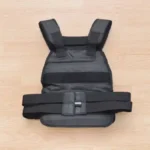
Key Takeaways
- Weighted vests provide deep pressure stimulation (DPS) , promoting relaxation and reducing anxiety & similar disorders.
- Potential benefits of sleeping with weighted vests include improved muscle recovery, postural support, and better sleep quality.
- Risks that are involved include restricted breathing, overheating, joint strain, and circulatory issues.
- Weighted vests are not suitable for individuals with respiratory conditions, circulatory disorders , musculoskeletal problems and other similar health issues.
- Weighted vests should be used cautiously , starting with a light weight then progressing and monitoring bodily responses.
Introduction
Sleeping with a weighted vest is an unconventional practice that has sparked curiosity among fitness enthusiasts, athletes, and individuals dealing with anxiety or sleep disorders. While weighted vests are primarily used for resistance training, some claim that wearing them during sleep can provide therapeutic benefits. Though these vests are mainly seen as tools for adding resistance in workouts there are voices out there suggesting their use at bedtime might just have healing effects.
On the other hand, some believe it could be harmful to one’s health. The piece delves into the unexpected advantages of using a weighted vest during sleep its possible downsides and questions if it’s an effective method for recuperation or a hazard to one’s health.
Understanding Weighted Vests
Weighted vests are garments designed to distribute additional weight across the torso, typically using sand, metal plates, or small weight packs.
People often use them to get stronger and last longer in their workouts or when they’re working to get better after an injury by adding more resistance to their exercise routine. But the idea of using them to help with sleep and getting better rest is something not many have tried yet and there isn’t much science out there to back it up.
The Benefits of Sleeping with a Weighted Vest
- Improved Deep Pressure Stimulation (DPS)
Weighted vests provide deep pressure stimulation (DPS), a therapeutic technique similar to weighted blankets. DPS has been shown to:
- Reduce cortisol levels (stress hormone)
- Increase serotonin and dopamine production (feel-good hormones)
- Promote relaxation and improve sleep quality
- Enhanced Muscle Recovery
For athletes and fitness enthusiasts, muscle recovery is crucial. Sleeping with a weighted vest may:
- Keep up a bit of resistance to keep your muscles working even when you’re relaxing.
- Enhancing the flow of blood aids in the swift delivery of nutrients to tired muscles.
- Ease the discomfort and tight feeling in muscles
- Anxiety and Stress Reduction
The calming effect of DPS is well-documented. Similar to weighted blankets used for anxiety relief, a weighted vest can:
- Help individuals with anxiety disorders by providing a grounding effect
- Reduce restlessness and improve overall sleep efficiency
- Benefit those with ADHD or sensory processing disorders by increasing body awareness
- Postural Support and Spinal Alignment
Sleeping in a weighted vest may aid in posture correction by:
- Keeping the upper body aligned
- Reducing instances of hunching, especially for individuals with poor sleeping postures
- Providing a slight counterforce that discourages unhealthy spinal curvature
- Potential Benefits for Insomnia Sufferers
Individuals struggling with insomnia may experience:
- Deeper, more restful sleep due to the comforting weight
- Fewer night-time awakenings caused by anxiety or discomfort
- Increased melatonin production due to reduced cortisol levels
The Potential Risks of Sleeping with a Weighted Vest
- Restricted Breathing and Circulation
One of the biggest concerns is the restriction of chest expansion while sleeping. This may:
- Lead to difficulty breathing, especially for individuals with respiratory conditions
- Cause reduced oxygen intake, leading to interrupted sleep cycles
- Increase the risk of sleep apnea or exacerbate existing conditions
- Increased Pressure on Joints and Spine
Prolonged use of a weighted vest during sleep may:
- Strain the shoulders, neck, and lower back
- Lead to joint discomfort or stiffness upon waking
- Worsen pre-existing musculoskeletal conditions such as scoliosis or arthritis
- Overheating and Sweating
Wearing a weighted vest can increase body temperature, leading to excessive sweating, which may:
- Disrupt sleep quality by causing discomfort
- Lead to dehydration if fluid loss is significant
- Exacerbate conditions such as hyperhidrosis (excessive sweating)
- Potential for Circulatory Issues
If the vest is too tight or too heavy, it may:
- Impede blood flow to extremities, causing numbness and tingling
- Increase the risk of blood clots, particularly in individuals prone to poor circulation
- Lead to nerve compression, resulting in long-term discomfort
- Psychological Dependence
While the vest may provide comfort, relying on it for sleep may create dependency, making it difficult to sleep without it. This can:
- Affect natural sleep patterns over time
- Lead to difficulty adjusting when traveling or in different sleeping conditions
Who Should Avoid Sleeping with a Weighted Vest?
Certain people might find this method helpful yet it’s not for everyone; caution is advised. Unless a doctor says it’s okay, these groups should steer clear of sleeping with a weighted vest:
- Individuals with respiratory conditions (asthma, sleep apnea, COPD)
- Those with circulatory disorders or blood pressure concerns
- People with musculoskeletal conditions such as scoliosis or arthritis
- Children or elderly individuals with fragile bone structures
- Pregnant women
Best Practices for Sleeping with a Weighted Vest
If you’re considering sleeping with a weighted vest, here are some tips to minimize risks:
- Start with a lighter weight: When picking out a vest make sure it weighs between 5% and 10% of what you weigh.
- Ensure proper fit: The vest should be snug but not restrictive.
- Monitor breathing and comfort: Should you find yourself out of breath or feeling uneasy stop using it right away.
- Use for short periods: Begin with putting it on for short sleeps or just a couple of hours before you decide to wear it all through the night.
- Stay hydrated: If sweating is an issue, increase fluid intake before bed.
- Choose a breathable material: Choose vests that are made of fabrics that draw sweat away to stop you from getting too hot.
Conclusion
Sleeping with a weighted vest is an emerging trend that has both potential benefits and risks. While it may aid in anxiety reduction, muscle recovery, and postural support, it also poses concerns related to breathing restriction, overheating, and joint pressure. For those curious about experimenting with this method, caution is the key. One should begin with a vest that’s not too heavy and keep a close eye on how their body reacts. In the end it’s wise to seek advice from a medical expert before adding a weighted vest to your bedtime habits particularly for those with health issues already in play.
References
- Grandin, T. (1992). Calming Effects of Deep Touch Pressure in Patients with Autism, College Students, and Animals. Journal of Child and Adolescent Psychopharmacology.
- Chen, H., Yang, J., & Chu, C. (2017). Weighted Blankets and Their Effects on Insomnia and Anxiety: A Review. Sleep Science.
- Steele, B. (2020). Effects of External Weight Loading on Sleep Quality in Adults. Journal of Sleep Research.
- National Sleep Foundation. The Impact of Sleep on Muscle Recovery and Performance. (2021).
By carefully weighing the benefits and risks, you can determine whether sleeping with a weighted vest is a viable option for improving your sleep and recovery.



